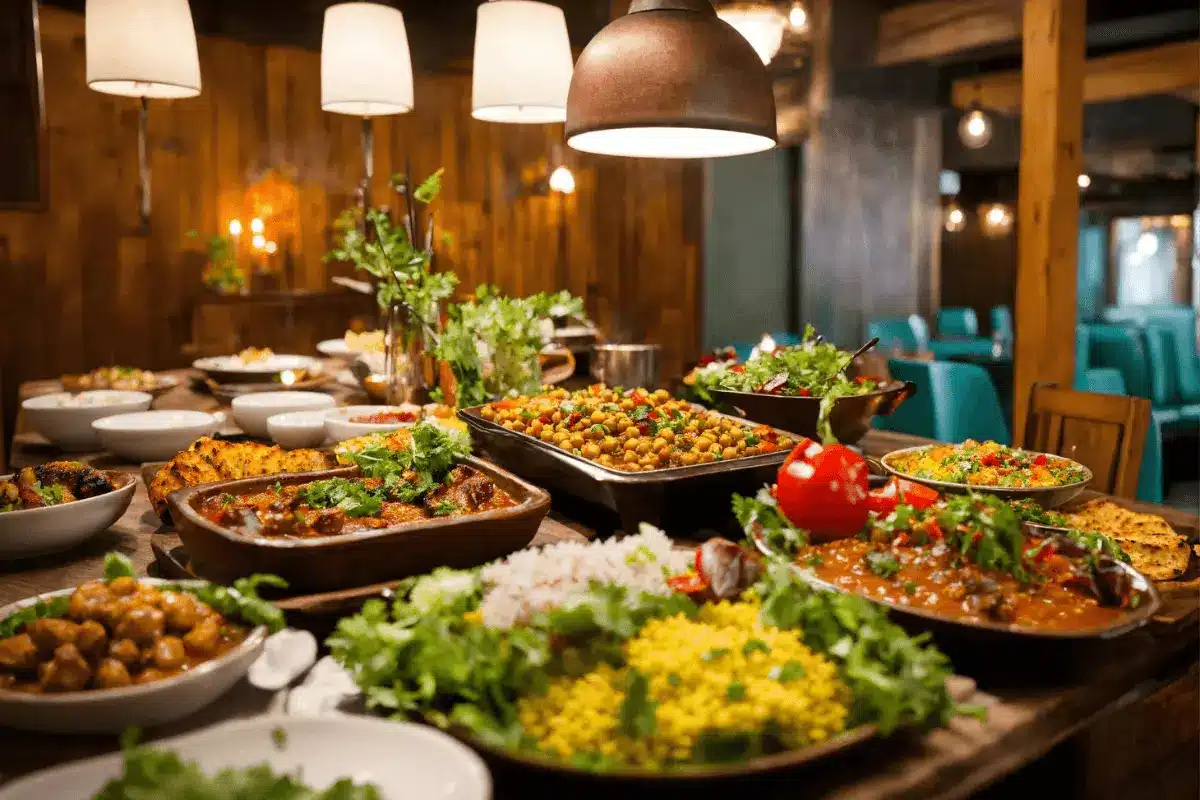Welcoming Vegetarian Guests
Welcoming a vegetarian guest to a dinner party can often prompt the question, “What to serve when one guest is vegetarian?” This article delves into the art of preparing a menu that caters to both vegetarian and non-vegetarian guests, ensuring everyone leaves the table satisfied. From understanding vegetarian dietary preferences to crafting a mixed-diet menu, we’ll guide you through the essentials of accommodating everyone’s needs without compromising on taste or variety.
Understanding Vegetarian Dietary Preferences
In today’s diverse culinary world, it’s not uncommon to find oneself hosting a gathering where at least one guest prefers a vegetarian diet. Understanding this choice is the first step in creating a welcoming atmosphere. For more insights into vegetarian cooking essentials, check out our comprehensive Vegetarian Cooking Guide. Vegetarianism, often chosen for health, ethical, or environmental reasons, involves a diet free from meat and sometimes other animal products.
Now, let’s be clear: accommodating a vegetarian doesn’t mean you have to overhaul your entire menu. It’s about adding thoughtful touches that show respect for their dietary choices. A little consideration goes a long way in making all your guests feel valued and included.
Catering to Vegetarians in a Mixed-Diet Gathering
The rise of vegetarianism in social settings reflects a broader shift towards more health-conscious and environmentally-friendly lifestyles. As a host, embracing this trend can be as simple as offering a variety of vegetarian-friendly meal options, much like the ones featured in our article on famous vegetarian dishes. This doesn’t just cater to vegetarians; it often introduces all guests to new, delicious food experiences.
Remember, the key here is balance. You’re aiming to create a menu that pleases everyone, without making your vegetarian guest feel like an afterthought. It’s about blending traditional favorites with innovative vegetarian dishes, ensuring a harmonious dining experience for all.
In the next section, we’ll dive into crafting a mixed-diet menu that seamlessly integrates dishes suitable for both vegetarian and non-vegetarian guests. Stay tuned for creative ideas that will elevate your hosting game!
Part 2: Crafting a Mixed-Diet Menu

What to Serve When One Guest is Vegetarian: Balancing Menus
When you’re pondering over what to serve when one guest is vegetarian?, it’s all about striking a balance. You want to ensure that every dish on the table is a delightful surprise, not just a mere afterthought. Start by considering dishes that naturally fit both diets – like a vibrant, zesty salad or a rich, hearty pasta. These universally appealing options can be a hit with everyone.
Moreover, let’s not forget about the power of customization. For instance, a build-your-own taco bar with a variety of fillings can cater to all tastes. It allows guests to tailor their meal to their liking, creating a fun and interactive dining experience.
Vegetarian-Friendly Meals: Ensuring Diversity and Satisfaction
Now, here’s the trick: balance. You don’t want your vegetarian guest nibbling on side dishes all night. Equally, you don’t want your meat-eaters feeling like they’re missing out. So, how about a main dish that’s a chameleon? Think stuffed bell peppers – with a meat filling option and a tantalizing quinoa and black bean version. Everyone’s happy, and no one feels left out.
Preventing Cross-Contamination in Vegetarian and Omnivore Menus
Cross-contamination is a real concern for many vegetarians. It’s crucial to be mindful of this when preparing your dishes. Simple steps, like using separate utensils and cooking surfaces for vegetarian and non-vegetarian items, can make a big difference. It shows your guests that you respect their dietary choices and are committed to accommodating them.
Versatile Dishes Suitable for Both Vegetarian and Non-Vegetarian Guests
Finally, let’s talk about versatility. Dishes like grilled vegetable skewers or a creamy mushroom risotto can be excellent additions. They’re not just sides; they’re stars in their own right. And for a twist, why not offer a gourmet veggie burger alongside the traditional beef patties? This way, everyone’s in for a treat, regardless of their dietary preferences.
Special Gift for Our Readers: Versatile Stuffed Bell Peppers Recipe
As a special treat for our readers, we’re excited to share an exclusive recipe that’s perfect for your next mixed-diet gathering: Stuffed Bell Peppers with both Vegetarian and Non-Vegetarian options. This recipe is not just a meal; it’s a celebration of diversity on your dining table!
Whether you have vegetarian guests or meat lovers in your group, these stuffed bell peppers are designed to please everyone. With a hearty filling of quinoa and black beans for vegetarians, and a savory mix of ground meat and rice for non-vegetarians, these peppers are a testament to how versatile and inclusive your cooking can be.
We’ve included some expert tips to ensure your stuffed peppers are a culinary delight. This recipe is our way of saying thank you for being a part of our community. We hope it adds flavor, joy, and a touch of creativity to your gatherings. Enjoy the smiles and compliments that are sure to come your way!
Part 3: Vegetarian Cooking Insights

Key Ingredients for Serving Meals for Vegetarian and Omnivore Guests
Diving into vegetarian cooking can be an exciting culinary adventure. The key is to stock up on essential ingredients that bring both nutrition and flavor to the table. Think of versatile staples like lentils, chickpeas, and tofu. These power-packed ingredients not only add substance to your dishes but also cater to the protein needs of your vegetarian guest.
Moreover, let’s not overlook the importance of fresh vegetables and fruits. They bring color, texture, and vital nutrients to every meal. Incorporating a variety of these into your dishes ensures that your vegetarian options are as nutritious as they are delicious.
Exploring Plant-Based Proteins and Nutrients
Now, when it comes to plant-based proteins, there’s a whole world to explore, including flavors from the Middle East, as seen in our Middle Eastern Vegetarian Recipes. Quinoa, tempeh, and edamame are just a few options that can be the cornerstone of your vegetarian dishes. They’re not only packed with protein but also offer a range of other nutrients that are essential for a balanced diet.
Using Herbs and Spices in Vegetarian-Friendly Meals
And here’s where the magic happens: herbs and spices. They are the secret weapons in your culinary arsenal. A sprinkle of fresh basil or a dash of smoked paprika can transform a simple dish into a culinary masterpiece. Don’t be afraid to experiment with different combinations to find what works best for your menu.
Cooking Techniques for Accommodating Vegetarian Dietary Needs
Finally, let’s delve into cooking techniques. Grilling, roasting, and sautéing, for example, can significantly enhance the natural flavors of your ingredients. Take, for instance, grilled asparagus or roasted sweet potatoes; these can be delightful additions to any meal. Moreover, these methods not only elevate the taste but also impart a gourmet touch to your vegetarian offerings, transforming simple ingredients into culinary delights. Additionally, experimenting with these techniques can bring a new dimension to your dishes, making even the most basic vegetables stand out. Furthermore, by mastering these methods, you can ensure that every meal is not only nutritious but also a feast for the senses.
Part 4: FAQs
Addressing Common Questions About Serving Vegetarian Guest
When it comes to hosting a mixed-diet gathering, a few questions invariably pop up. Let’s tackle some of the most common ones, ensuring you’re well-prepared for your next event.
Ensuring Adequate Protein in Vegetarian Options
Q: How can I make sure my vegetarian dishes are protein-rich?
A: It’s a common misconception that vegetarian meals lack protein. In reality, however, there are plenty of plant-based protein sources. Legumes, nuts, seeds, and tofu, for example, are excellent options. Additionally, dishes such as a lentil salad or a chickpea stew can be both satisfying and protein-packed, offering a nutritious and flavorful alternative to traditional protein sources.
Creating Unified Dishes for Mixed Dietary Preferences
Q: What to serve when one guest is vegetarian and others are not?
A: The key is to find dishes that can be easily adapted for both diets. For instance, a pasta dish with a choice of meatballs or grilled vegetables allows everyone to enjoy a similar meal. This approach not only simplifies your cooking process but also ensures that no one feels singled out based on their dietary choices. Furthermore, it promotes a sense of unity at the dining table, as all guests can share in the same culinary experience, albeit with variations that suit their individual preferences.
Preventing Cross-Contamination in the Kitchen
Q: How can I prevent cross-contamination when preparing and serving a vegetarian and non-vegetarian dishes?
A: Good kitchen hygiene is crucial. Use separate cutting boards and utensils for vegetarian and non-vegetarian ingredients. Also, be mindful when using shared cooking surfaces or appliances. Simple steps like these can make a big difference in ensuring that your vegetarian dishes remain true to their nature.
Q: How can I ensure my vegetarian dishes are nutritionally adequate?
A: It’s a common misconception that vegetarian meals lack protein. Read the American Dietetic Association’s position on vegetarian diets for detailed information.
Part 5: Concluding Thoughts
As we wrap up our discussion on “What to serve when one guest is vegetarian,” it’s clear that hosting a dinner where dietary preferences vary widely doesn’t have to be a challenge. In fact, it’s an exciting opportunity to showcase your culinary versatility. Whether you’re accommodating a vegetarian guest or catering to a mix of dietary needs, the key is in thoughtful preparation and embracing diversity.
Now, consider those times when you’re faced with the question, “What to serve when one guest is vegetarian?” For such occasions, versatility is your best friend. A dish like our Stuffed Bell Peppers, adaptable for both vegetarians and meat-eaters, is an excellent example. It demonstrates that with a bit of creativity, you can effortlessly please all your guests.
Furthermore, remember, the essence of great hosting lies in making everyone feel welcome and included. Whether it’s a casual family dinner or a larger social gathering, your efforts to cater to various dietary needs will be greatly appreciated. So, the next time you’re planning a menu, keep in mind the diverse preferences of your guests.
Key Takeaways for Hosting Vegetarian and Omnivore Guests
In conclusion, our key takeaways from “What to serve when one guest is vegetarian” include understanding vegetarian dietary preferences, crafting a balanced mixed-diet menu, and embracing adaptable recipes. By following these strategies, you can confidently prepare meals that delight all your guests, regardless of their dietary choices.
Hosting a mixed-diet gathering can indeed be a delightful and enriching experience. With a little planning, creativity, and adaptable recipes, you can easily cater to all tastes and preferences, ensuring every guest feels valued and satisfied.
For more inspiration and ideas, don’t hesitate to explore additional resources. Websites like Vegetarian Society and Additionally, for insights into vegetarian nutrition, the Academy of Nutrition and Dietetics is an excellent resource.


4 thoughts on “What to Serve When One Guest is Vegetarian? – Inclusive Dining Tips”